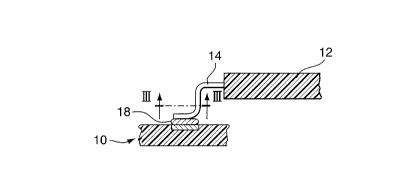Some of the information on this Web page has been provided by external sources. The Government of Canada is not responsible for the accuracy, reliability or currency of the information supplied by external sources. Users wishing to rely upon this information should consult directly with the source of the information. Content provided by external sources is not subject to official languages, privacy and accessibility requirements.
Any discrepancies in the text and image of the Claims and Abstract are due to differing posting times. Text of the Claims and Abstract are posted:
| (12) Patent: | (11) CA 2214130 |
|---|---|
| (54) English Title: | ASSEMBLIES OF SUBSTRATES AND ELECTRONIC COMPONENTS |
| (54) French Title: | ENSEMBLES DE SUBSTRATS ET DE COMPOSANTS ELECTRONIQUES |
| Status: | Deemed expired |
| (51) International Patent Classification (IPC): |
|
|---|---|
| (72) Inventors : |
|
| (73) Owners : |
|
| (71) Applicants : |
|
| (74) Agent: | DE WILTON, ANGELA C. |
| (74) Associate agent: | |
| (45) Issued: | 2003-12-02 |
| (22) Filed Date: | 1997-08-28 |
| (41) Open to Public Inspection: | 1998-03-19 |
| Examination requested: | 1999-07-16 |
| Availability of licence: | N/A |
| (25) Language of filing: | English |
| Patent Cooperation Treaty (PCT): | No |
|---|
| (30) Application Priority Data: | ||||||
|---|---|---|---|---|---|---|
|
An assembly of a substrate and an electrical or
electronic component, the component having electrically
conductive leads with surfaces of an alloy of tin and
copper and the leads being soldered to copper based
terminals of the substrate by a solder alloy of tin and
copper. Lead solder is thus avoided. Preferably each
conductive lead has a surface layer of the alloy of tin and
copper and core within the surface layer of another
material which remains solid at the soldering temperature
of the surface layer. Also included is a method of
soldering a component with electrically conductive leads
having surfaces of tin and copper alloy to copper based
terminals by a solder alloy of tin and copper.
L'invention est un ensemble constitué par un substrat et un composant électrique ou électronique, ce composant ayant des conducteurs à surface en alliage d'étain et de cuivre qui sont soudés à des bornes à base de cuivre du substrat au moyen d'un alliage de soudure d'étain et de cuivre. On évite ainsi la soudure au plomb. Dans la concrétisation privilégiée de l'invention, chaque conducteur a une couche de surface en alliage d'étain et de cuivre et, sous cette couche de surface, une âme faite d'un autre matériau qui reste solide à la température de soudure de la couche de surface. Une méthode est également révélée pour souder à des bornes à base de cuivre, au moyen d'un alliage de soudure d'étain et de cuivre, un composant ayant des conducteurs électriques à surfaces en alliage d'étain et de cuivre.
Note: Claims are shown in the official language in which they were submitted.
Note: Descriptions are shown in the official language in which they were submitted.

For a clearer understanding of the status of the application/patent presented on this page, the site Disclaimer , as well as the definitions for Patent , Administrative Status , Maintenance Fee and Payment History should be consulted.
| Title | Date |
|---|---|
| Forecasted Issue Date | 2003-12-02 |
| (22) Filed | 1997-08-28 |
| (41) Open to Public Inspection | 1998-03-19 |
| Examination Requested | 1999-07-16 |
| (45) Issued | 2003-12-02 |
| Deemed Expired | 2005-08-29 |
There is no abandonment history.
| Fee Type | Anniversary Year | Due Date | Amount Paid | Paid Date |
|---|---|---|---|---|
| Application Fee | $300.00 | 1997-08-28 | ||
| Registration of a document - section 124 | $100.00 | 1998-02-18 | ||
| Registration of a document - section 124 | $100.00 | 1998-02-18 | ||
| Request for Examination | $400.00 | 1999-07-16 | ||
| Maintenance Fee - Application - New Act | 2 | 1999-08-30 | $100.00 | 1999-07-16 |
| Registration of a document - section 124 | $0.00 | 2000-02-02 | ||
| Maintenance Fee - Application - New Act | 3 | 2000-08-28 | $100.00 | 2000-05-25 |
| Maintenance Fee - Application - New Act | 4 | 2001-08-28 | $100.00 | 2001-07-26 |
| Maintenance Fee - Application - New Act | 5 | 2002-08-28 | $150.00 | 2002-08-19 |
| Registration of a document - section 124 | $0.00 | 2002-10-30 | ||
| Maintenance Fee - Application - New Act | 6 | 2003-08-28 | $150.00 | 2003-07-31 |
| Final Fee | $300.00 | 2003-09-11 |
Note: Records showing the ownership history in alphabetical order.
| Current Owners on Record |
|---|
| NORTEL NETWORKS LIMITED |
| Past Owners on Record |
|---|
| BELL-NORTHERN RESEARCH LTD. |
| BILTON, DAVID |
| HAMILTON, MURRAY W. |
| NORTEL NETWORKS CORPORATION |
| NORTHERN TELECOM LIMITED |
| TRUMBLE, WILLIAM PATRICK |